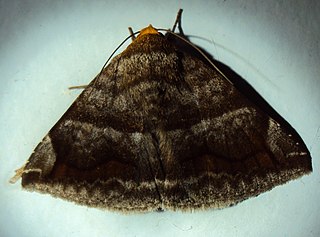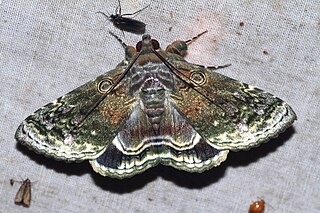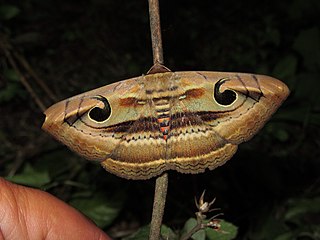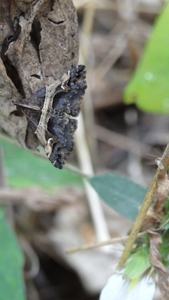
Dordura is a monotypic moth genus of the family Noctuidae erected by Frederic Moore in 1882. Its only species, Dordura aliena, was first described by Francis Walker in 1865. It is found in the Indian subregion, Sri Lanka, Myanmar, Thailand, Peninsular Malaysia, Sumatra, Borneo and New Guinea.

Buzara onelia is a moth of the family Erebidae. It is found from the Indian subregion to Sri Lanka, Myanmar, Sundaland, the Philippines and Japan.

Buzara umbrosa is a moth of the family Erebidae. It is found in China, India and Sri Lanka.

Ctenoplusia limbirena, the Scar Bank gem, or silver U-tail, is a moth of the family Noctuidae. It is found in south-western Europe, Africa, the Canary Islands, Arabia, the southern Himalayas, India, Sri Lanka, Indochina to south-eastern China, Taiwan, Sulawesi, Bali and Timor. In New Zealand, it has been established since 2011.
Diarsia ochracea is a moth of the family Noctuidae. It is found in Sri Lanka. It is found where tea is cultivated.

Acosmeryx shervillii, the dull forest hawkmoth, is a moth of the family Sphingidae. The species was first described by Jean Baptiste Boisduval in 1875. It is found from the Indian subregion, Sri Lanka, to Sundaland, the Philippines and Sulawesi. Acosmeryx pseudonaga is sometimes treated as a valid species.

Chiasmia emersaria is a moth of the family Geometridae. The species was first described by Francis Walker in 1861. It is found in India, Nepal, northern Thailand, China, Sri Lanka, Japan and the Ryukyu Islands.

Mnesiloba dentifascia is a moth of the family Geometridae first described by George Hampson in 1891. It is known from the Oriental tropics.

Cyclodes omma is a moth of the family Noctuidae. It is found from the Oriental tropics to the Moluccas, including India, Nepal, Vietnam, Cambodia, Myanmar, Thailand, Malaysia, Java, Bali, Sumatra, Timor, Sri Lanka, Flores, Sulawesi, the Philippines, China and Taiwan.

Gesonia obeditalis is a species of moth of the family Noctuidae first described by Francis Walker in 1859. It is found from eastern Africa, the Seychelles, the Maldives and the Oriental tropics of India, Myanmar, Sri Lanka east to the Philippines, the Sula Islands and Australia. The adult moth has brown wings with a scalloped dark brown band near the margin. The hindwings are similar in pattern to the forewings but are a paler shade of brown.

Spirama retorta, the Indian owlet-moth, is a moth of the family Erebidae. The species was first described by Carl Alexander Clerck in 1764. It is found in China, Korea, Japan (Honshu), India, Nepal, Bangladesh, Thailand, Cambodia, Myanmar, Vietnam, Taiwan, Sri Lanka, Malaysia, the Philippines (Luzon), Indonesia ,Japan.
Gymnoscelis admixtaria is a moth in the family Geometridae. It was described by Francis Walker in 1862. It is found in Sri Lanka, India and Japan.
Gymnoscelis deleta is a moth in the family Geometridae. It is found in India, Korea, Japan, Taiwan and probably in Sri Lanka according to Hampson.
Pomasia reticulata is a moth in the family Geometridae first described by George Hampson in 1895. It is found in the Mergui Archipelago of Myanmar and in Penang in Peninsular Malaysia and in Borneo. The habitat primarily consists of coastal areas.
Acantholipes trajecta is a species of moth in the family Erebidae first described by Francis Walker in 1865. It is found in South Africa, India, Sri Lanka, and Australia, where it has been recorded from Western Australia, the Northern Territory and Queensland.

Bertula abjudicalis is a moth of the family Noctuidae first described by Francis Walker in 1859. It is found in India, Thailand, Laos, Vietnam, Taiwan and from Sri Lanka to Australia, where it has been recorded from New South Wales.
Neotogaria galema is a moth in the family Drepanidae first described by Swinhoe in 1894. It is found in Bangladesh.
Dreata is a monotypic moth genus in the family Eupterotidae described by Francis Walker in 1855. Its single species, Dreata hades, described by the same author in the same year, is found in Bangladesh, Myanmar and India.
Eupterote testacea is a moth in the family Eupterotidae. It was described by Francis Walker in 1855. It is found in India and Myanmar.
Eupterote patula is a moth in the family Eupterotidae. It was described by Francis Walker in 1855. It is found in Thailand, Myanmar and India.










